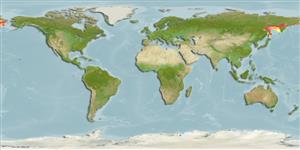>
Perciformes/Cottoidei (Sculpins) >
Cottidae (Sculpins)
Etymology: Artediellus: Petrus (Peter) Artedi, (10 Mar.) 1705-35 (28 Sep.), a son of a clergyman from Anundsjö named Olaus Arctaedius, in the northern part of Sweden.In 1729 he changed his name from Arctaedius to Arctædi, a name still later simplified to Artedi (Ref. 45335).
Environment: milieu / climate zone / depth range / distribution range
Ekologi
marina bottenlevande; djupintervall 37 - 520 m (Ref. 50610). Temperate
Western Pacific: eastern Kamchatka and northern Anadyr Gulf and western Bering Sea.
Size / Vikt / Age
Maturity: Lm ? range ? - ? cm
Life cycle and mating behavior
Könsmognad | Reproduktion | Lek | Ägg | Fecundity | Larver
Quast, J.C. and E.L. Hall, 1972. List of fishes of Alaska and adjacent waters with a guide to some of their literature. U.S. Dep. Commer., NOAA Tech. Rep. NMFS SSRF-658, 47 p. (Ref. 6876)
IUCN Red List Status (Ref. 130435)
Threat to humans
Harmless
Human uses
Ytterligare information
PopulärnamnsynonymerMetabolikPredatorerEkotoxikologiReproduktionKönsmognadLekSpawning aggregationFecundityÄggEgg development
Age/Size
Tillväxt
Length-weight
Length-length
Length-frequencies
Morfometri
Morfologi
Larver
Larvdynamik
Rekrytering
Abundans
BRUVS
referenserVattenbrukVattenbruksprofilAvelslinjerGenetikElectrophoresesÄrftlighetSjukdomarBehandlingNutrientsMass conversion
MedarbetareBilderStamps, Coins Misc.LjudCiguateraHastighetSimsättGälytaOtolithsHjärnstorlekSyn
Verktyg
Special reports
Download XML
Internet-källor
Estimates based on models
Preferred temperature (Ref.
123201): -0.8 - 2.9, mean 1 °C (based on 156 cells).
Phylogenetic diversity index (Ref.
82804): PD
50 = 0.5000 [Uniqueness, from 0.5 = low to 2.0 = high].
Bayesian length-weight: a=0.01000 (0.00244 - 0.04107), b=3.04 (2.81 - 3.27), in cm total length, based on all LWR estimates for this body shape (Ref.
93245).
Trofisk nivå (Ref.
69278): 3.4 ±0.4 se; based on size and trophs of closest relatives
Resiliens (Ref.
120179): Mellan, lägsta populationsfördubblingstid 1,4-4,4 år (Preliminary K or Fecundity.).
Fishing Vulnerability (Ref.
59153): Low vulnerability (10 of 100).
